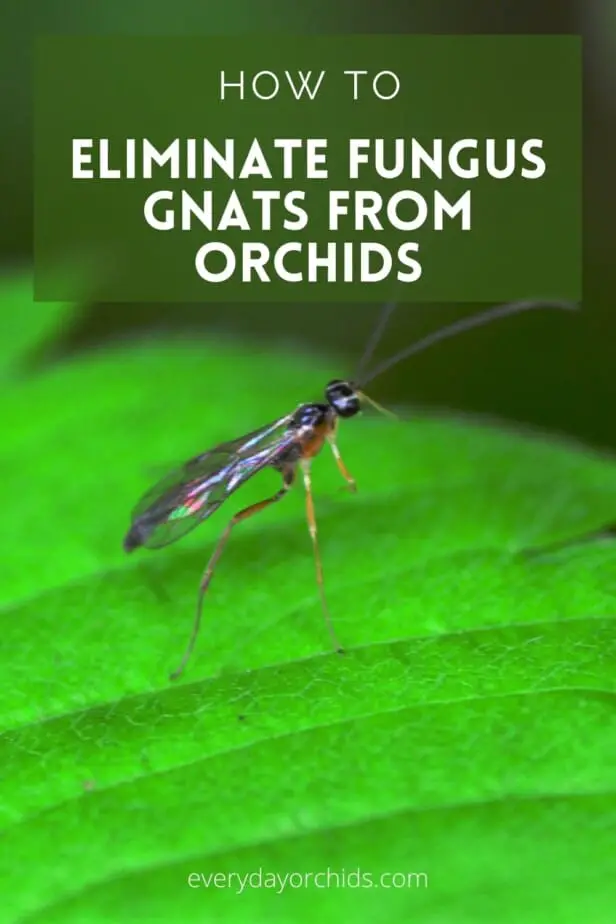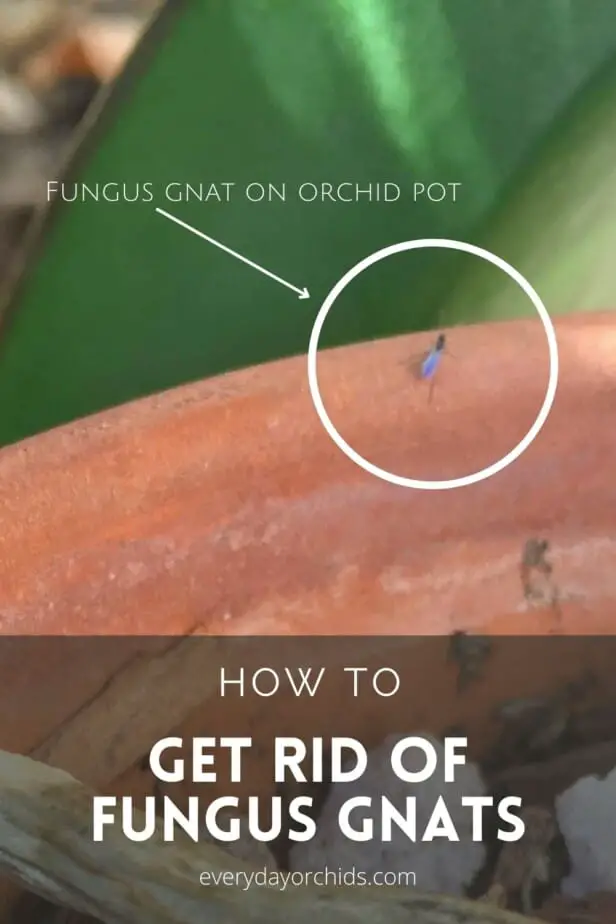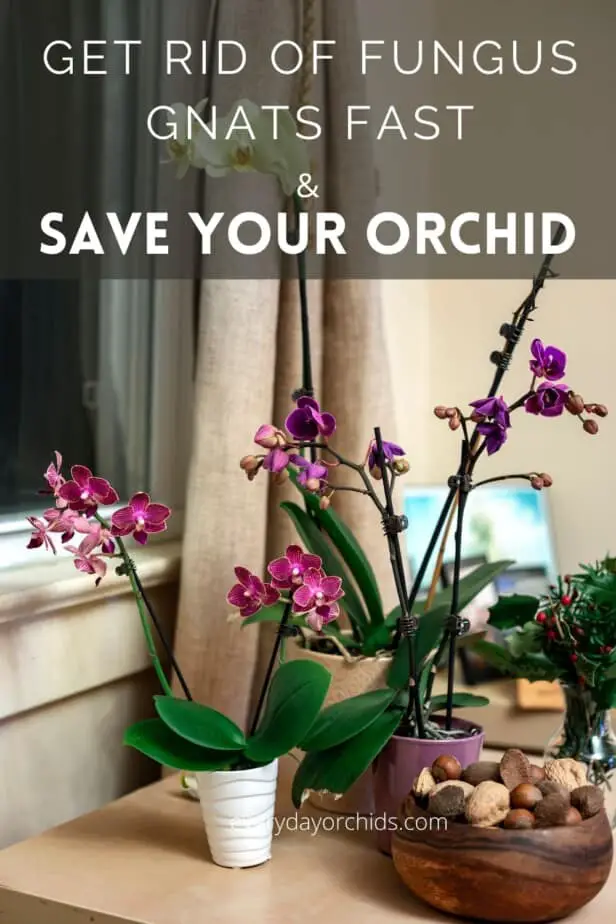Many orchid growers will encounter, at some point in time, fungus gnats around their orchid and wonder how to get rid of these bugs. These orchid gnats look like fruit flies, but are actually smaller in size. Up close, they almost look like tiny mosquitos.
Fungus gnats, also known as orchid gnats, are common orchid pests. As soon as you notice these bugs around your orchid plant, you will need to take action. Left alone to continue to breed and grow their population, fungus gnats can cause a great deal of harm to your orchid.
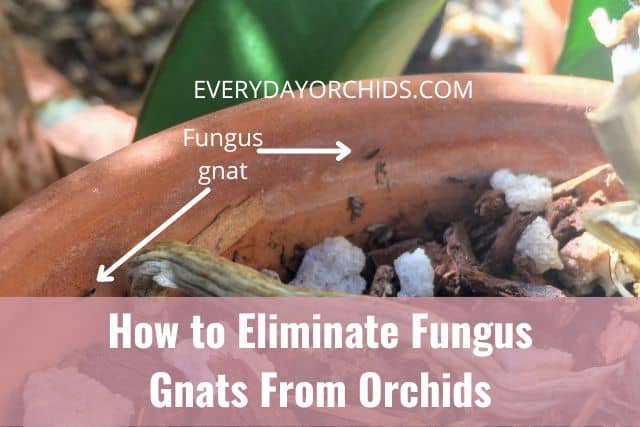
Fungus gnats around an orchid plant are a signal that your potting media is decaying or your orchid has root rot. These gnats are one of the few orchid pests that need to be dealt with immediately in order to prevent further damage to your orchid. You will need to stop and disrupt the fungus gnat larvae lifecycle, as well as trap and kill the adults.
In this article, I will go over what causes a fungus gnat infestation in your orchid plant. You will learn how to deal with an active fungus gnat infestation on your orchids using a variety of methods. I’ll also provide some tips on how to prevent future fungus gnat infestations. Keep reading to learn more.
Please note that these links are affiliate links and as an Amazon Associate, I earn from qualifying purchases. Purchases made through affiliate links in this post may generate commissions at no additional cost to you. Use this link for a discounted Amazon Prime trial. Thank you for your support!
Table of Contents
What are Fungus Gnats?
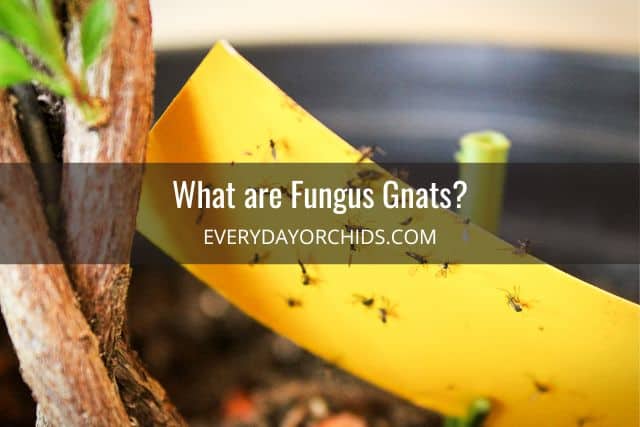
As mentioned above, fungus gnats are tiny, black flies similar in appearance to fruit flies, but smaller. They range from 1/16 to 1/8 inch in length. These gnats have clear or light gray wings. Fungus gnat larvae are about 5/32 inches (or a little over 1/8 inches) long. Larvae have black heads and long white, or tan-colored bodies.
Fungus gnats are a problem for orchid growers, but can be found with many other plants as well. These pesky insects are common problems in greenhouses or nurseries, where many plants are grown close together.
Oftentimes, the growing environment in these buildings is humid and warm, encouraging growth of fungus gnats. The air currents within the building, meant to maintain air circulation around the plants, serves to transport insects from one plant to another.

If you lift up your orchid pot, you will disturb these gnats. Movement of the pot or any disturbance will cause the orchid gnats to fly up and swarm around the plant.
Fungus gnats will often stay near the potted plant and not fly around the rest of the house. They rest on the damp potting media or on the edges of the pot when they are not flying. Unfortunately, fungus gnats can be hard to spot as they tend to blend in with the potting media.
Life Cycle of Fungus Gnats
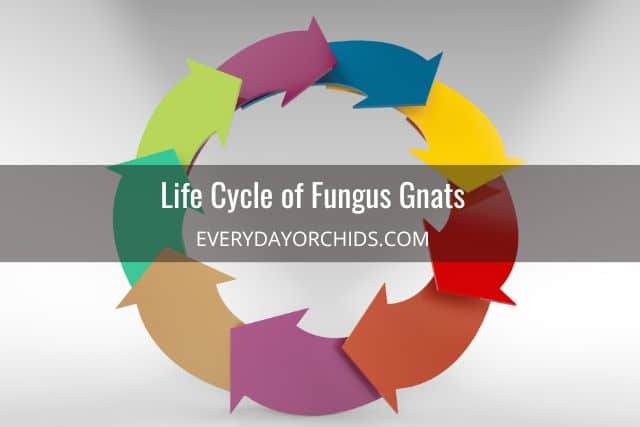
The cycle starts when female fungus gnats lay their eggs in the moist decaying organic material. One female gnat can lay dozens of eggs at a time. If temperatures and conditions are right, the eggs can hatch in as little as just 3 days.
Once the eggs hatch and larvae emerge, they will begin eating the decaying orchid potting media around them. If there is a large population of fungus gnat larvae, you may even see shiny lines or trails across sections of the potting media. This is because as the larvae navigate in and around the potting media, they leave trails of slime, similar to snails and slugs.
The fungus gnat larvae will take about 10 days to further develop into pupae, the next stage in their growth cycle. Pupae will continue to eat and grow. After just another 4 days, they become adults. These adults are then able to reproduce and lay more eggs, beginning the cycle again.
If left unchecked, a fungus gnat infestation can quickly explode to become a huge problem and spread to your other plants. The life cycle of a fungus gnat is about 3 weeks.
In warmer temperatures, development is actually even faster, leading to shorter cycles and a larger fungus gnat population over time. This, my friends, can become a big problem.
What Do Fungus Gnats Eat in Your Orchid Plants?
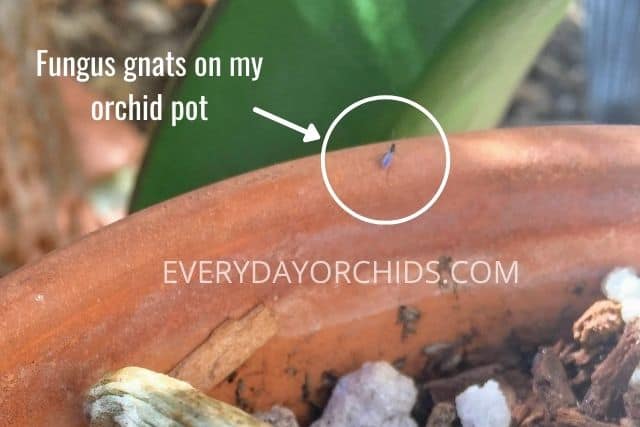
Fungus gnats are attracted to decaying organic material. This can be the orchid potting media, if you haven’t changed it in several years. Root rot also attracts fungus gnats. Fungus gnats eat the decaying potting media but also bite rotted and healthy orchid roots.
How Do Fungus Gnats Harm Your Orchid Plant?
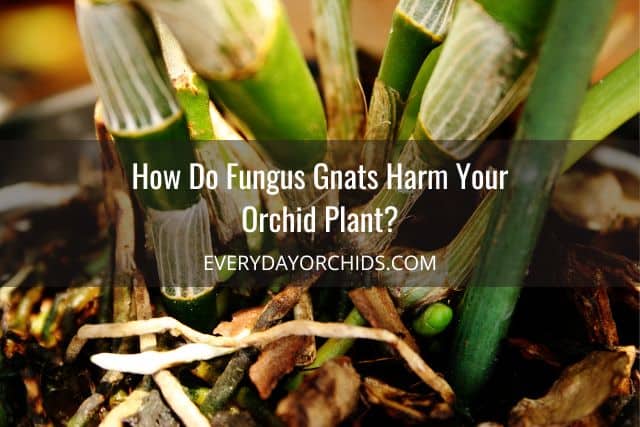
Fungus gnats can be detrimental to orchids and other houseplants for a number of reasons.
Fungus Gnats Spread Disease
These little pests can carry viral, bacterial, or fungal pathogens from plant to plant. In a greenhouse or nursery setting, fungus gnats can quickly and easily spread disease among various plants.
This is why it is important to carefully inspect your orchid plant before buying it. Even after you bring it home, keep it separate from the rest of your orchids and houseplants for at least one to two weeks, possibly more. This will give you a chance to ensure that the newly purchased plant is not harboring pests or diseases that you didn’t catch in the store.
Fungus Gnats Cause Root Damage and Stunted Growth
Remember, the fungus gnats and fungus gnat larvae are present due to decaying media or rotting roots. This means that the orchid plant was under some stress to begin with.
Fungus gnat larvae will bite and chew orchid roots, causing further root damage in an already stressed orchid plant. If there are a lot of fungus gnat larvae, they can even cause stunted plant growth. The orchid might not recover from this if there is significant damage, even if you get rid of the fungus gnats.
If you notice your orchid leaves are wilting despite regular watering, this can be due to a fungus gnat infestation as well as root rot.
How to Treat and Eliminate a Fungus Gnat Infestation

Looking at the life cycle of the fungus gnat above, you can see that the majority of the fungus gnat’s life is spent in the potting media and soil before the adult stage. Therefore, it would make the most sense to target the potting media in order to control the infestation.
The eggs, fungus gnat larvae and pupae are not flying at this stage, making them easier to get rid of. Trust me, it is hard to catch the flying adult fungus gnats. I have tried to catch them with my hands, but they are just too small and quick. More info on how to trap the adult fungus gnats below.
Isolate the Infected Orchid
Once you have identified the problem, you will need to immediately isolate the infected plant away from your other healthy plants. Inspect the neighboring plants as well for larvae or adult gnats around the pots or potting media.
As mentioned earlier, these fungus gnats can spread between plants. Chances are by the time you spot a winged pest infestation in one plant, multiple plants are affected.
If you have an orchid that clearly has a fungus gnat infestation, place it in an area where the pests will not be able to spread to other plants. As the pupae grow into adults, some will fly out to seek new homes. You want to prevent this as much as possible.
If you have an outdoor space you can use, and one that is free of other plants, place your infested orchid plant here, weather permitting. This will allow the potting media to further dry out and improve airflow around your orchid.
Fungus gnats proliferate indoors because they don’t have any natural predators inside the house. This allows them to grow unchecked. Outdoors however, fungus gnat predators include spiders, ladybugs, and soil mites. These natural predators will help keep your orchid’s fungus gnat problem at bay until you can repot the plant.
Use Hydrogen Peroxide to Kill Fungus Gnat Larvae
To kill the larvae, prepare a mixture of one part hydrogen peroxide to four parts water in a spray bottle. Mix well and spray this solution over the potting media. This will not hurt the orchid plant. Repeat at least once a week until fungus gnat larvae are gone.
However, this is just another stop gap measure until you can repot your plant. You will still need to repot the orchid in order to address the core issue of rotting roots and decomposing potting media.
Repot Your Orchid To Get Rid of the Fungus Gnat Eggs, Larvae and Pupae
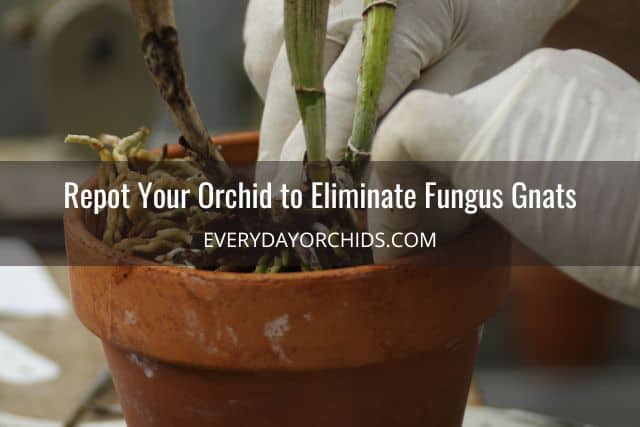
First and foremost, you will need to repot your orchid if you have a fungus gnat infestation. If fungus gnats are present, you already know that the potting media is decaying and decomposing. Otherwise, they wouldn’t be there, right?
Use new orchid potting media when you repot your orchid. Try to select potting media that has components which are slow to decompose, like perlite, charcoal, or coconut husk fiber. This will help deter future fungus gnat problems. If you want to learn more about how to choose the right potting media, you can check out my resource on orchid potting media.
In addition, before using your new potting media, inspect it carefully to make sure it doesn’t contain any pests. Unfortunately, a brand new bag of potting media can harbor pests. There have been cases where bags of orchid potting mix were found to be infested with eggs, larvae, and even adult pests.
The enclosed, damp environment of the bags can encourage growth of bacteria, mold, and pests. If these bags are placed out in the sun at the local garden center for days on end, the warm temperatures only serve to hasten growth of unwanted pests and mold.
You can boil the orchid potting media prior to using it, as a way to kill off any bacteria or mold spores or pests. If you have the time, you can also solarize the potting media, a process that takes 4-6 weeks. This article about fungus gnats goes into more detail about that and you can read about it here.
You can also make your own orchid potting media, by buying each component separately or choosing inorganic material to pot your orchid. Hydroponics are one way to grow orchids without using orchid potting media. You can also use alternative methods to grow your orchids if you prefer.
Trap the Adult Fungus Gnats
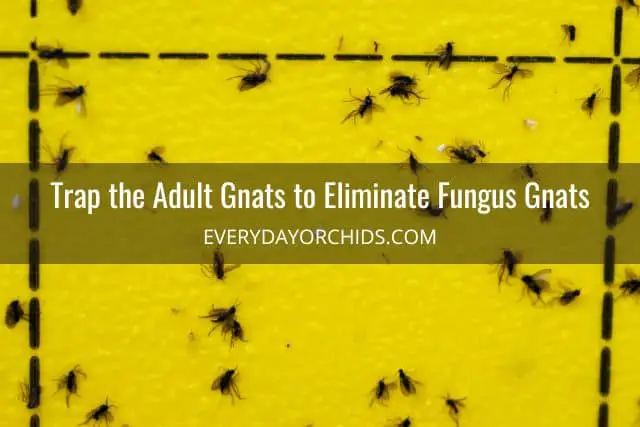
The most important step in stopping a fungus gnat infestation is to eliminate the eggs, fungus gnat larvae and pupae. Repotting and removing all the decaying media and rotted roots will accomplish this.
Using new potting media will stop future population growth because the eggs, larvae and pupae are now gone.
The second most important step is to kill off the adult fungus gnats. This will prevent reproduction and laying of eggs. There are a few ways to do this.
Yellow Sticky Traps
Using yellow sticky traps is probably one of the most popular ways to trap adult fungus gnats. Honestly, the color doesn’t really matter for fungus gnats. A lot of sticky traps that are sold are yellow, since this color attracts many other insects. You can buy yellow sticky traps at your local hardware store or online and place these near your orchid plants.
Adult fungus gnats do not fly far from the plant they are inhabiting, so place these sticky traps near the base of the plant. One option is to cut up the yellow sticky traps into smaller sizes and hang them from the underside of orchid leaves near the potting media.
You can also put the yellow sticky trap on a stick and place the stick directly in the potting media. That will capture adult gnats flying around the potting media. The more traps you have set up around your orchid plant, the more fungus gnats you will be able to catch.
Raw Potato
Some gardeners like to use raw potato chunks to lure fungus gnats away from the plants and over to the potato. Fungus gnat larvae like potatoes and will leave the orchid roots in order to go eat the potato chunk.
It might take a day or two before you see this happening, so be patient. Leave the potato chunk in the potting media for a few days. Once it is infested with fungus gnat larvae, dispose of it in a sealed plastic bag and replace it with a fresh potato chunk.
Realistically, this process takes days. In that period, more eggs will hatch and larvae will continue to grow. If you want to try the raw potato method, do so for only a short time. Plan to repot as soon as possible.
I personally am not a fan of the raw potato method, because it just gives the fungus gnats more time to reproduce and grow their population. I say just repot your orchid and get it over with.
Apple Cider Vinegar or Beer
Adult fungus gnats are attracted to the fermentation in beer or apple cider vinegar. You can use this method if you have a severe infestation and are wanting to trap as many adult fungus gnats as possible before you repot.
Pour a small amount, about 2 ounces of apple cider vinegar or beer, into a cup. Add a few drops of liquid dish washing soap. The soap breaks the surface tension of the water. Insects will sink the bottom instead of being able to walk along the top of the water.
Place this cup of apple cider vinegar or beer next to the orchid plant. The fungus gnats will fly down into the cup, attracted by the smell of the fermented liquid, and drown.
The issue with this method is that it only addresses the adult fungus gnats. In the meantime, the eggs, fungus gnat larvae and pupae will move through the life cycle and become adults, who will then lay eggs. If you want to use this to trap some of the adult fungus gnats, that is fine, but don’t let this be your only intervention.
Biological Control
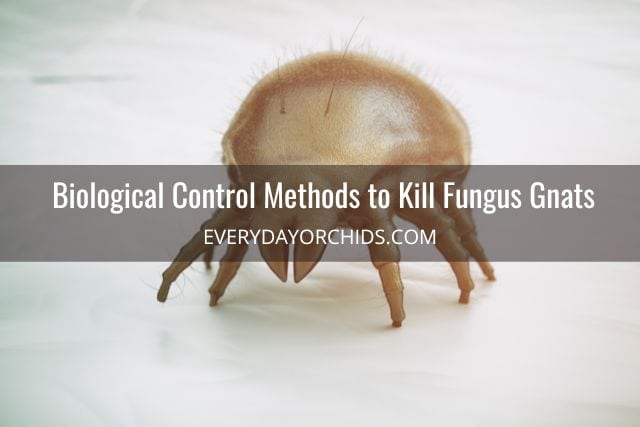
Biological control is an alternative method used to manage fungus gnat infestations. Bacteria, nematodes or predatory mites can kill fungus gnats and help control the fungus gnat population. Typically this would not be necessary for a household collection of orchids, especially if only one or two plants are infested.
Biological control methods are more commonly used in greenhouses or nurseries. Those with large orchid and houseplant collections may also prefer to use biological control to deal with fungus gnats.
Bacillus Thuringiensis Israelensis
Bacillus thuringiensis israelensis (BTI) is a bacterial treatment targeting fungus gnat larvae. This is a key component in mosquito dunks. Not only do they kill mosquito larvae, but BTI will kill fungus gnat larvae as well. It is safe to use around plants, pets, and people.
Buying the smaller BTI bits will allow you to place this in your orchid humidity trays. You can buy this online as Gnatrol. Mix this with water and wet the infected areas, in this case, the potting media. It only works for 48 hours so you will need to reapply more than once in order to get the fungus gnat infestation under control.
Nematodes
Nematodes can also be used to control fungus gnat populations. These biological control agents target the fungus gnat larvae, killing them before they have a chance to further develop into pupae or adults.
One option is the nematode Steinernema carpocapsae, which is sold as ScanMask. Another option is Nemasys, which contains Steinernema feltiae. Nature’s Good Guys makes a product contains three different types of nematodes and can be used on both indoor and outdoor plants, not just orchids.
Predatory Mites
Predatory mites such as Hypoaspsis miles also kill fungus gnat larvae. These mites are sold online or at specialty stores.
To use them, sprinkle the mites on the potting media, or mix them into the potting media. They will run into the potting media and seemingly disappear. Don’t worry though, they will still be there, but are just hard to see.
The mites will eat dead insects, fungus gnat maggots, thrips pupae and other pests. They will also feed on the fungus gnat larvae. Of all the biological control methods mentioned, this is probably the longest lasting, as the mites can live for a long time.
Insecticides
Some may want to know if you can use an insecticide to deal with this issue.
You can use pyrethrin, which is an insecticide that should be used with caution. Pyrethrin has the benefit of deterring or killing fungus gnats, but it is also very toxic to fish and humans. If you have small pets or children, I would not recommend using this product in your home.
Insecticide use should be the last resort for your orchid. The fact of the matter is, even if you spray a chemical pesticide on your orchid’s potting media, you will still have old potting media in the orchid pot.
You need to deal with the root cause (sorry for the pun, haha) of the problem in order to completely eliminate the fungus gnats.
On top of that, spraying pesticides on the orchid potting media, where aerial and superficial roots may be exposed to the chemicals, is risky. You could end up harming and further stressing your orchid plant.
How to Prevent Fungus Gnats
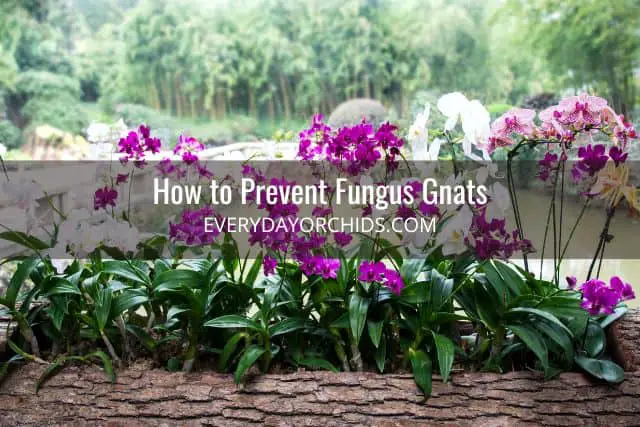
As you can now know, dealing with fungus gnats in orchids is no joke. It’s a lot of work to get rid of fungus gnats from plants. The best thing to do is prevent fungus gnats from ever infecting your orchids in the first place. Here are some ways you can do that.
Inspect your orchid plants regularly
Check your orchids on a regular basis not just for fungus gnats, but for any sort of pest infestation or infection that is brewing.
If you can carve out a few minutes each day to do this, you will be able to catch the problem early on. By catching it early, you will be able to deal with it while it is still a small infestation or problem. In the long run, this will save you time and stress. It might even save your orchid’s life.
When you are inspecting your orchid plants, look for any adult gnats resting on the edges of the orchid pot or in the potting media. There may be a few small gnats hovering around the orchid plant itself.
If you aren’t sure if there are fungus gnats, you can easily find out by picking up the orchid pot, or using your finger to move around the top layer of the orchid potting media. If there are adult fungus gnats around, they will immediately fly up and around the plant. You may notice shiny slime trails across the potting media or larvae with shiny black heads and white or light brown long bodies roaming around.
Before buying any new plant, including orchid plants, inspect your new orchid carefully for signs of disease or pests. Once you bring the plant home, keep it separate from your other houseplants for at minimum 2 to 4 weeks until you are sure it is not harboring pests or disease.
If you find that your new orchid does have fungus gnats or fungus gnat larvae in the potting media, repot it and prune off the rotted roots. Make sure that you’ve gotten rid of the fungus gnats before you place your new orchid with your other plants.
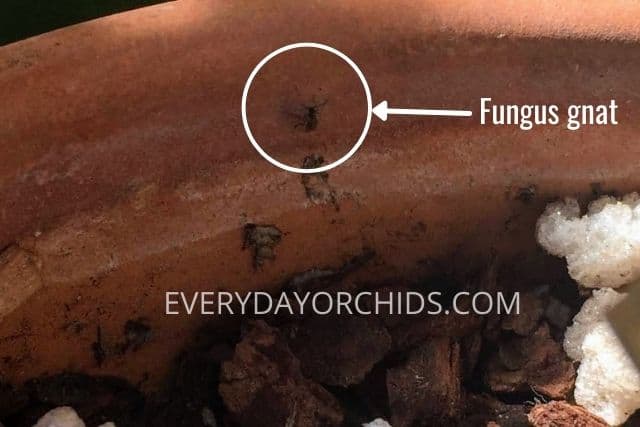
Repot your orchid regularly
Fungus gnats are attracted to decaying or decomposing material, and old orchid potting media is no exception. The older the potting media is, the higher the chances it will attract fungus gnats. Rotting orchid roots, moist potting media and decaying plant matter attract fungus gnats. If left untreated, the eggs will hatch into orchid gnat larvae, leading to a greater infestation.
Most epiphytic orchids in a traditional orchid pot will need to be repotted every 1-2 years. Many terrestrial orchids will need to be repotted every 2-3 years.
When purchasing orchid potting media, make sure that it has a healthy portion of perlite, charcoal, and other inorganic material mixed in. Use well-draining, slow-to-decompose orchid potting media. This will help with drainage and aeration for the orchid roots. It will also prevent the potting media from staying damp for long periods of time. This in turn will go a long way in preventing fungus gnat infestations.
Watering practices
Do your best not to overwater your orchid plant. Overwatering causes root rot and hastens the decomposition rate of the orchid potting media.
Before you water your orchid, place your finger in the top two inches of the potting media to check for dampness. If it is still damp, don’t water just yet. Wait until the potting media is nearly dry before you water your orchid.
Fungus gnats lay their eggs in the top layer of the potting media. They will only do so in damp, decaying potting media. Allowing the potting media to almost dry out between watering will prevent the adult fungus gnats from laying eggs in the top layer of potting media. Instead, they will move on to a more hospitable environment. Hopefully this is nowhere near your plants.
After watering your orchid plants, empty out any saucers or trays under the orchid pots. Preventing standing water from remaining under your orchids will help prevent the potting media from remaining moist. Fungus gnats are attracted to damp or moist potting media.
In addition, emptying out the saucers will help prevent bacterial, fungal and viral pathogens from multiplying and infecting your orchid.
For more information, check out this guide on how to water your orchid.
Choose the Right Pot for Your Orchid
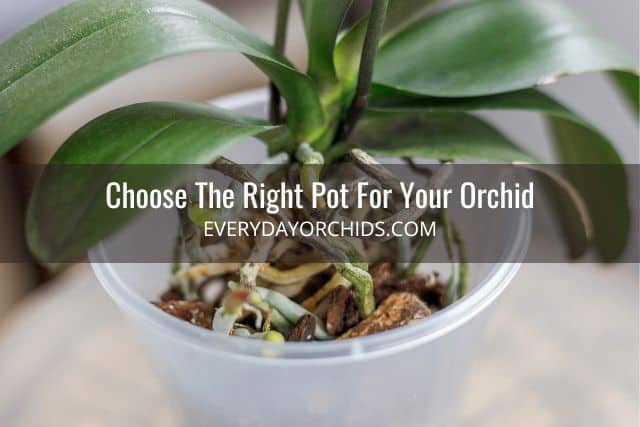
Make sure your orchid plant has good aeration and drainage in the orchid pot. This will allow the orchid potting media to dry out between watering.
Fungus gnat eggs and larvae will die if the potting media is dry. When choosing an orchid pot, select one with slits or holes on the sides to allow for air flow.
Use a pot that is specially made for orchids. Select one that has holes or slits on the sides of the pot to allow for drainage and air flow. I use these clear plastic pots with side slits for my orchids, then double pot them into a more attractive container.
Please check out this resource on how to choose an orchid pot to learn more.
Use Mosquito Dunks
If you are using a humidity tray for your orchid plants, you can place a small piece of mosquito dunk in the water of the tray. This contains BTI, a biological control, and will help prevent fungus gnats from being attracted to your humidity tray.
If you have pets or small children however, this is not recommended. Curious pets or small children may accidentally eat the mosquito dunk, which is poisonous.
Prune Your Orchid Regularly
Prune off any dead or rotted roots each time you repot your orchid plant.
In addition, regularly prune off and remove dead flower spikes and orchid leaves from your orchid. As spent orchid blooms fall and come to rest in the potting media, throw them out instead of leaving them there.
Limiting the amount of decaying organic material present around your orchid will help deter fungus gnat infestations. After all, if there is no food to eat and the living environment is not hospitable, fungus gnats will not be attracted to your orchid.
Avoid Over Fertilizing
Over fertilizing your orchid plants can cause root burn and fertilizer salts to build up in the potting media. It can also speed up the decomposition process of your potting media.
If you think about it, most orchid fertilizer is diluted with water. Each time you fertilize your orchid, you are also watering it. More frequent watering accelerates the break down of potting media, which will attract fungus gnats to your orchids.
Final Thoughts
Fungus gnats are an annoying orchid pest that will also affect your other household plants and garden plants. It is a common problem for many orchid growers, so don’t feel bad if you see fungus gnats around your orchids.
Regular inspection of your orchids will help you catch an infestation early. Use the methods outlined above to deal with a fungus gnat infestation and stop them from further damaging your orchids. I’ve included many tips for preventing future fungus gnat infestations as well. I hope this helps you. Happy orchid growing!
If you enjoyed this article, please pin it and share!
